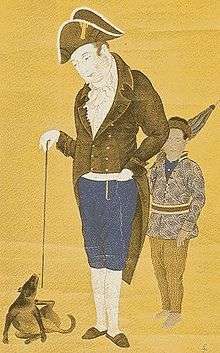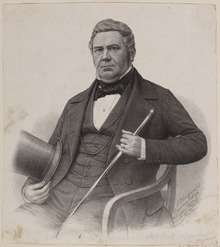VOC Opperhoofden in Japan

VOC Opperhoofden in Japan were the chief traders of the Dutch East India Company (Vereenigde Oostindische Compagnie or VOC in old-spelling Dutch, literally "United East Indian Company") in Japan during the period of the Tokugawa shogunate, also known as the Edo period.
Opperhoofd is a Dutch word (plural opperhoofden) which literally means 'supreme head[man]'. In its historical usage, the word is a gubernatorial title, comparable to the English chief factor, for the chief executive officer of a Dutch factory in the sense of trading post, as led by a factor, i.e. agent. The Japanese called the Dutch chief factors kapitan (from Portuguese capitão).
The Dutch East India Company was established in 1602 by the States-General of the Netherlands to carry out colonial activities in Asia. The VOC enjoyed unique success in Japan, in part because of the ways in which the character and other qualities of its Opperhoofden were perceived to differ from other competitors.
Trading posts or factories

Hirado, 1609–1639
.jpg)
The first VOC trading outpost in Japan was on the island of Hirado off the coast of Kyūshū. Permission for establishing this permanent facility was granted in 1609 by the first Tokugawa-shōgun Ieyasu; but the right to make use of this convenient location was revoked in 1639.
Dejima, 1639–1860

In 1638, the harsh Sakoku ("closed door" policy) was ordered by the Tokugawa shogunate; and by 1641, the VOC had to transfer all of its mercantile operations to the small man-made island of Dejima in Nagasaki harbor. The island had been built for the Portuguese, but they had been forced to abandon it and all contacts with Japan. Only the Dutch were permitted to remain after all other Westerners had been excluded.
The Dutch presence in Japan was closely monitored and controlled. For example, each year the VOC had to transfer the opperhoofd. Each opperhoofd was expected to travel to Edo to offer tribute to the shogun (Dutch missions to Edo). The VOC traders had to be careful not to import anything religious; and they were not allowed to bring any females, nor to bury their dead ashore. They were largely free to do as they pleased on the island; but they were explicitly ordered to work on Sunday.
For nearly 200 years a series of VOC traders lived, worked and seemed to thrive in this confined location.
In 1799 the VOC went bankrupt. The trade with Japan was continued by the Dutch Indian government at Batavia, with an interruption during the English occupation of Java, during which the English (Stamford Raffles) unsuccessfully tried to capture Dejima. After the creation of the Kingdom of The Netherlands (1815) the trade with Japan came under the administration of the Minister of the Colonies by way of the Governor General in Batavia. The directors of the trade (Opperhoofd) became colonial civil servants. From 1855 the director of the trade with Japan, J.H. Donker Curtius, became 'Dutch Commissioner in Japan' with orders to conclude a treaty with Japan. He succeeded in 1855 to conclude a convention, changed into a treaty in January 1856. In 1857 he concluded a commercial paragraph in addition to the treaty of 1856, thus concluding the first western treaty of friendship and commerce with Japan. His successor, J.K. de Wit was Dutch Consul General in Japan, though still a colonial civil servant. In 1862 the Dutch representation in Japan was transferred to the Ministry for Foreign Affairs. This change was effected in Japan in 1863, Dirk de Graeff van Polsbroek becoming Consul General and Political Agent in Japan.
List of chief traders at Hirado
Hirado (平戸島 Hirado-shima) is a small island just off the western shore of the Japanese island of Kyūshū.[1] In the early 17th century, Hirado was a major center of foreign trade and included British, Chinese, and other trading stations along with the Dutch one, maintained and operated by the VOC after 1609. The serial leaders of this VOC trading enclave or "factory" at Hirado were:
- Jacques Specx: 20.9.1609 - 28.8.1612
- Hendrick Brouwer: 28.8.1612 - 6.8.1614
- Jacques Specx: 6.8.1614 - 29.10.1621
- Leonardt Camps: 29.10.1621 - 21.11.1623
- Cornelis van Nijenroode: 21.11.1623 - _._.1631
- Pieter Stamper: 1631
- Cornelis van Nijenrode: _._.1631 - 31.1.1633
- Pieter van Sante or Pieter van Santen: 31.1.1633 - 6.9.1633
- Nicolaes Couckebacker: 6.9.1633 - _._.1635[2]
- Maerten Wesselingh or Hendrick Hagenaer (?): _._.1635-_._.1637
- Nicolaes Couckebacker: _._.1637 - 3.2.1639[3]
- François Caron: 3.2.1639 - 13.2.1641 Caron was the last Opperhoofd at Hirado.[4]
List of chief traders at Dejima


Dejima (出島) was a fan-shaped artificial island in the bay of Nagasaki. This island was a Dutch trading post during Japan's period of maritime restrictions (海禁, kaikin, 1641–1853) during the Edo period. The serial leaders of this VOC trading enclave or "factory" at Dejima were:
|
- Janus Henricus Donker Curtius: 2.11.1852 - 28.2.1860 [Donker Curtius became the last in a long list of hardy Dutch Opperhoofden who were stationed at Dejima; and fortuitously, Curtius also became the first of many Dutch diplomatic and trade representatives in Japan during the burgeoning pre-Meiji years.]
References
- ↑ The island and the adjacent coastal stretch on Kyushu are nowadays part of Hirado-City 平戸市 (Hirado-shi)
- ↑ Historigraphical Institute (Shiryō hensan-jo), University of Tokyo, "Diary of Nicolaes Couckebacker"; retrieved 2013-2-1.
- ↑ Shiryō, "Diary of Nicolaes Couckebacker"; retrieved 2013-2-1.
- ↑ Dejima opperhoofden chronology; Caron chronology (German); Boxer, Charles Ralph, ed. (1935). A True Description of the Mighty Kingdoms of Japan & Siam, p. LXII; Shiryō, "Diary of François Caron"; retrieved 2013-2-1.
- ↑ Shiryō, "Diary of Maximiliaen Le Maire"; retrieved 2013-2-1.
- ↑ Shiryō, "Diary of Jan van Elseracq"; retrieved 2013-2-1.
- ↑ Shiryō, "Diary of Pieter Anthonisz Overtwater"; retrieved 2013-2-1.
- ↑ Shiryō, "Diary of Pieter Jan van Elseracq"; retrieved 2013-2-1.
- ↑ Shiryō, "Diary of Pieter Anthonisz Overtwater"; retrieved 2013-2-1.
- ↑ Shiryō, "Diary of Renier van Tzum"; retrieved 2013-2-1.
- ↑ Shiryō, "Diary of Willem Verstegen"; retrieved 2013-2-1.
- ↑ Shiryō, "Diary of Frederick Coyet"; retrieved 2013-2-1.
- ↑ Shiryō, "Diary of Dircq Snoecq"; retrieved 2013-2-1.
- 1 2 3 4 5 Kornicki, Peter F. "European Japanology at the End of the Seventeenth Century," Bulletin of School of Oriental and African Studies, University of London. Vol. 56, No. 3 (1993). pp. 510.
- 1 2 3 4 Kornicki, p. 507.
Sources
- Blomhoff, J.C. (2000). The Court Journey to the Shogun of Japan: From a Private Account by Jan Cock Blomhoff. Amsterdam
- Blussé, L. et al., eds. (1995–2001) The Deshima [sic] Dagregisters: Their Original Tables of Content. Leiden.
- Blussé, L. et al., eds. (2004). The Deshima Diaries Marginalia 1740-1800. Tokyo.
- Boxer. C.R. (1950). Jan Compagnie in Japan, 1600-1850: An Essay on the Cultural, Artistic, and Scientific Influence Exercised by the Hollanders in Japan from the Seventeenth to the Nineteenth Centuries. Den Haag.
- Caron, F. (1671). A True Description of the Mighty Kingdoms of Japan and Siam. London.
- (Dutch) de Winter, Michiel. (2006). "VOC in Japan: Betrekkingen tussen Hollanders en Japanners in de Edo-periode, tussen 1602-1795" ("VOC in Japan: Relations between the Dutch and Japanese in the Edo-period, between 1602-1795").
- Doeff, H. (1633). Herinneringen uit Japan. Amsterdam. [Doeff, H. "Recollections of Japan" ISBN 1-55395-849-7]
- Edo-Tokyo Museum exhibition catalog. (2000). A Very Unique Collection of Historical Significance: The Kapitan (the Dutch Chief) Collection from the Edo Period—The Dutch Fascination with Japan. Catalog of "400th Anniversary Exhibition Regarding Relations between Japan and the Netherlands," a joint project of the Edo-Tokyo Museum, the City of Nagasaki, the National Museum of Ethnology, the National Natuurhistorisch Museum" and the National Herbarium of the Netherlands in Leiden, the Netherlands. Tokyo.
- Leguin, F. (2002). Isaac Titsingh (1745-1812): Een passie voor Japan, leven en werk van de grondlegger van de Europese Japanologie. Leiden.
- Nederland's Patriciaat, Vol. 13 (1923). Den Haag.
- Screech, Timon. (2006). Secret Memoirs of the Shoguns: Isaac Titsingh and Japan, 1779-1822. London.
- Siebold, P.F.B. v. (1897). Nippon. Würzburg e Leipzig.
- Titsingh, I. (1820). Mémoires et Anecdotes sur la Dynastie régnante des Djogouns, Souverains du Japon. Paris.
- Titsingh, I. (1822). Illustrations of Japan; consisting of Private Memoirs and Anecdotes of the reigning dynasty of The Djogouns, or Sovereigns of Japan. London.
See also
- Dutch missions to Edo
- Rangaku - Dutch studies
- The Thousand Autumns of Jacob de Zoet
Sources and external links
| Wikimedia Commons has media related to Dejima. |
- Original list of opperhoofden (in Dutch)
- Dejima: The Island Comes Back to Life
- A map of Deshima
- At the bottom you will also find an image of Deshima
- WorldStatesmen - Japan
Coordinates: 32°44′37″N 129°52′23″E / 32.743525°N 129.873022°E
